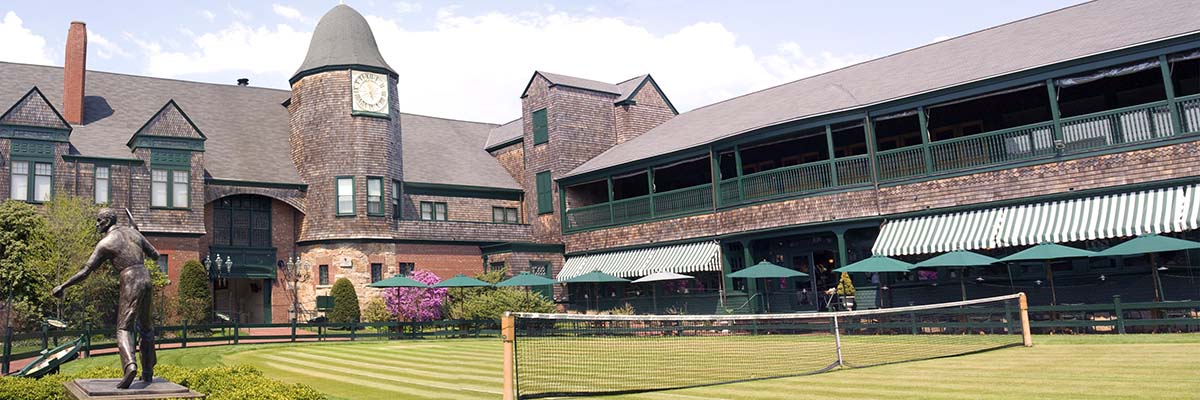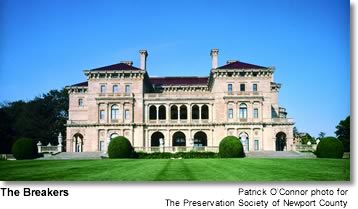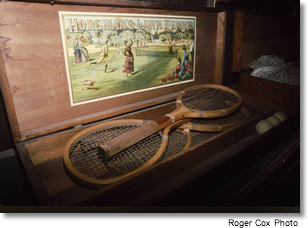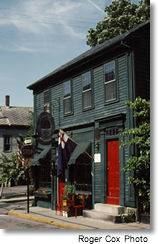
A Tennis Player's Newport, Rhode Island
In the late 1980s, Bill Bryson set off to explore America in his mother's aging Chevette, a journey he later chronicled in his irreverent travelogue The Lost Continent: Travels in Small-Town America. Along the way he stopped in Newport,  Rhode Island where he followed a footpath called Cliff Walk, which edges the Atlantic Ocean as it circles behind some of the community's most celebrated mansions. He had his eye out for The Breakers, the baronial 72-room summer "cottage" that Cornelius Vanderbilt II had constructed in 1895. Built in Renaissance revival style, it is the grandest of these American chateaux. Bryson passed one palatial house after another until finally he encountered what could only be the Vanderbilt mansion. "It was absolutely enormous, a mountain with windows," he wrote. "You can't look at it without thinking that nobody, with the possible exception of oneself, deserves to be that rich."
Rhode Island where he followed a footpath called Cliff Walk, which edges the Atlantic Ocean as it circles behind some of the community's most celebrated mansions. He had his eye out for The Breakers, the baronial 72-room summer "cottage" that Cornelius Vanderbilt II had constructed in 1895. Built in Renaissance revival style, it is the grandest of these American chateaux. Bryson passed one palatial house after another until finally he encountered what could only be the Vanderbilt mansion. "It was absolutely enormous, a mountain with windows," he wrote. "You can't look at it without thinking that nobody, with the possible exception of oneself, deserves to be that rich."

Whether they deserve to be that rich or not, the exceedingly wealthy have been part of Newport's social fabric since the early 19th century. Founded in 1639 by settlers seeking religious freedom, Newport originally prospered as a seaport.  Its naturally protected harbor on Narragansett Bay became a center for the burgeoning maritime trade between the North American colonies and the Caribbean.
Its naturally protected harbor on Narragansett Bay became a center for the burgeoning maritime trade between the North American colonies and the Caribbean.
That era ended when the British blockaded the harbor during the Revolutionary War, but Newport soon found new prosperity as a summer escape for southern planters and well-to-do urbanites lured by a temperate climate. During its Gilded Age, the Rhode Island seaport became an area where Vanderbilts vied with each other and with the Astors, Belmonts, Oelrichs and Wetmores to see who could spend the most money on a place they'd occupy no more than 12 weeks a year. Many of these so-called cottages line Bellevue Avenue, turning the leafy boulevard into a necklace of palazzi, temples, and chateaux, one more ostentatious than the next.
Poised between the colonial heart of town and the Bellevue Avenue mansions stands yet another landmark from the gilded age: the Newport Casino and the International Tennis Hall of Fame. An arched entryway in its gabled facade leads into the quadrangle of the Horseshoe Piazza and an earlier century. Inside, a single grass court has been laid out in a long oval of lawn framed by the red brick and forest-green latticework of the Casino building itself. A clock tower, with a shingled roof whimsically shaped like an English bobby's helmet, rises at one end. Chinese dogwood, blue hydrangea, and impatiens bloom in the corners.
Yet for all its hushed Victorian gentility, the Casino was born as an act of revenge. In 1879, James Gordon Bennett, Jr., the wealthy publisher of the New York Herald and a prominent Newport cottager, grew incensed when then socially formidable Newport Reading Room revoked a friend's guest privileges for committing the unspeakable act of riding a horse through the Bellevue Avenue men's club. Bennett took the revocation as a personal affront and within days had purchased approximately five acres of land a quarter mile down Bellevue Avenue as the site for a sports pavilion he would call the Casino. He sold shares in the project, eventually signing up a Who's Who of the Newport Social Register. He then hired the then fledgling architectural firm of McKim, Mead, and White to design it. The Casino opened on July 28, 1880, and instantly became the place to be seen.
Bennett had filled much of the acreage with grass courts for tennis, a new sport very much in vogue among the elite. So in 1881 when the newly formed U.S. National Lawn Tennis Association went in search of a venue for its first-ever U.S. Tennis Championships, the Newport Casino was the obvious choice. The national championships continued to be held there every summer until 1915, when the event moved to the West Side Tennis Club in Forest Hills, New York. Undaunted, the Casino established its own invitational tournament and, except during World War II, has continued to hold tennis competitions every summer since. It is now the oldest tennis tournament venue in the world (the Wimbledon Championships started in 1877 but moved to the All England Club in 1922).
It could just as easily have been demolished, as Bennett's villa across the street was, to make room for a shopping center. Although it reopened following World War II, it had lost its luster and ambience. The court tennis court, constructed in 1880, and adjacent theater both had been damaged badly by fire. A large part of the acreage to the south was sold off (to become yet another shopping complex), reducing the number of grass courts from 40 to 13. Like many of the mansions in Newport, it had become an aging white elephant, rare and exquisite but past its prime and costly to maintain.
The Casino was rescued by James H. Van Alen, a fourth-generation Newport cottager and president of the club. In 1954, he secured the USLTA's sanction to establish a Tennis Hall of Fame at the Casino. He further convinced shareholders to donate or sell their interest in the club to the Hall of Fame. The change from exclusive private club to public tennis center meant that everyone was welcome to play on the fabled lawns, making these the only competition grass courts in the world open to the masses.
But these are not just any grass courts. Part of the excitement of playing there comes from knowing that through the last 130 years, many of the greats of tennis have competed on these same lawns. Newport continues to hold men's and women's tournaments during the summer, garnering publicity as the only remaining professional grass-court event in the U.S. But its activities for the public remain among the nation's best-kept secrets. Not only are the courts open for play to anyone off the street, but the staff also sets up matches and runs several round robins and clinics each week.
Several of the Casino's former club rooms  house the International Tennis Hall of Fame Museum, the world's largest depository of tennis memorabilia. One exhibit highlights the 218 people who have been enshrined in the Hall of Fame. Others focus on the four Grand Slam events, Davis Cup, women in tennis and, most intriguing of all, the history of equipment, which among other paraphernalia includes an 1892 boxed tennis set, consisting of four racquets, balls, a net, posts and instructions.
house the International Tennis Hall of Fame Museum, the world's largest depository of tennis memorabilia. One exhibit highlights the 218 people who have been enshrined in the Hall of Fame. Others focus on the four Grand Slam events, Davis Cup, women in tennis and, most intriguing of all, the history of equipment, which among other paraphernalia includes an 1892 boxed tennis set, consisting of four racquets, balls, a net, posts and instructions.
The changes at the Casino over the last 70 years parallel the evolution of Newport itself. Its well-to-do summer residents now share the seaport's considerable charms with carloads of tourists. If commercialism runs rampant and parking is maddeningly difficult, there is nonetheless a rare beauty to be found in everything from the exquisite mansions to the craggy cliffs, quaint streets lined with colonial buildings, and views of blue water flecked with white sails. Visitors may stroll along Cliff Walk, play tennis on the historic lawns at the Casino, watch the sunset over drinks on one of the historic quays, and dine on fresh seafood. No one, with the possible exception of oneself, deserves a vacation this rich.
Newport Essentials
For information about Newport attractions special events,
and a brochure  summarizing hotel accommodations contact the Newport & Bristol
County Convention & Visitors Bureau, 23 America's Cup
Ave. Newport, RI 02840 or phone toll-free 800-326-6030. The
grass courts at the Newport Casino Lawn Tennis Club are open
from mid May through September. The public is welcome
to play on its grass at $45/person/hour or to participate in
any of the weekly round robins and low-cost weekend clinics.
Tennis whites are requested but not required. The International
Tennis Hall of Fame Museum is open from 9:30 a.m. to 5 p.m. year
round except on Thanksgiving, Christmas, New Year's Day and
during the annual Newport Hall of Fame pro tournaments in early
July. Admission is $11 for adults and $9 for seniors, military,
or students with ID. Children 16 and under are admitted free. For
information, contact the International Tennis Hall of Fame, 194 Bellevue Ave., Newport, RI
02840 or phone 401-849-3990.
summarizing hotel accommodations contact the Newport & Bristol
County Convention & Visitors Bureau, 23 America's Cup
Ave. Newport, RI 02840 or phone toll-free 800-326-6030. The
grass courts at the Newport Casino Lawn Tennis Club are open
from mid May through September. The public is welcome
to play on its grass at $45/person/hour or to participate in
any of the weekly round robins and low-cost weekend clinics.
Tennis whites are requested but not required. The International
Tennis Hall of Fame Museum is open from 9:30 a.m. to 5 p.m. year
round except on Thanksgiving, Christmas, New Year's Day and
during the annual Newport Hall of Fame pro tournaments in early
July. Admission is $11 for adults and $9 for seniors, military,
or students with ID. Children 16 and under are admitted free. For
information, contact the International Tennis Hall of Fame, 194 Bellevue Ave., Newport, RI
02840 or phone 401-849-3990.


